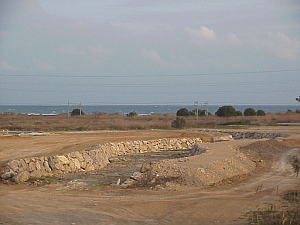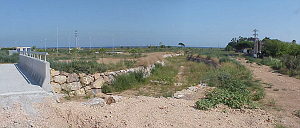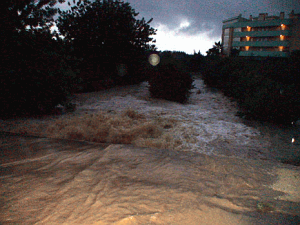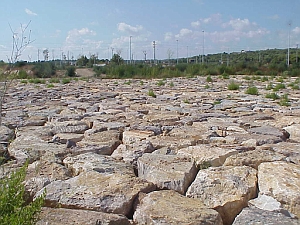When coastal development and conservation collide: Els Muntanyans, Torredembarra
There are economic benefits and environmental costs to coastal development which influence the success of the development equation. Els Muntanyans on the Costa Dorada provides a case study where the costs are perceived to outweigh the benefits and coastal development pressures have been reduced by recent court action (February 2008).
 |
| Els Muntanyans, Torredembarra (February 2008) |
Planning permission has been given for the
construction of 550 homes, parks and facilities covering 173,900 m² on the edge
of coastal marshland and dunes at Els Muntanyans in Torredembarra. The Els
Muntanyans beach is the last remaining large natural beach on the Catalan coast
between the Llobregat Delta to the south of Barcelona and the Ebro Delta.
The development, a second phase of construction at the site, designated Els
Muntanyans II, is located at the mouth of the Gibert torrent and covers the
biological corridor that connects the adjacent beach and Protected Natural Area
of Interest (PEIN), with the protected rural interior.
The Government Directorate General of Coasts recognised the importance of the
biological corridor in a 2001 report, which recommended the purchase of the land
together with the adjacent Muntanyans I site, and its incorporation into the PEIN
Plan. However, the Torredembarra Town Council through Pla Partial Platja de
Torredembarra 4b Muntanyans II, has promoted housing development in the area.
The housing at Els Muntanyans I is advertised as a good location for a second
home: 'Una segunda residencia diseñada con el confort de su primera residencia'
(a second home designed to be as comfortable as your main residence). The
development is now nearly completed and construction of Els Muntanyans II has
started (February 2008).
Promoter Els Muntanyans I: Grupo Plaza 14 and Torredembarra Town Council
Promoter Els Muntanyans II: Vegas Guadaira S.L. and Torredembarra Town Council
 |
| Locations of Muntanyans I and Muntanyans II |
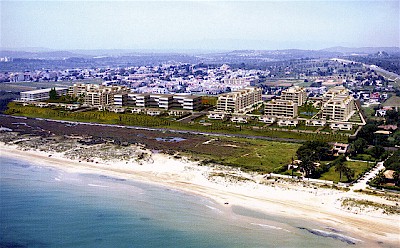 |
| Els Muntanyans I - Nova Torredembarra - the first construction phase near completion (February 2008). |
 |
| Els Muntanyans I - Nova Torredembarra Promoter's Model |
The Els Muntanyans development has been opposed on environmental and social grounds, and its impact includes a number of external costs borne by society as a whole. The environmental and social costs can be summarised as follows:
|
Environmental Costs
|
|||||||||||||||||||
|
Social costs
|
| The Actors
Groups For Company Vegas Guadaira S.L. Groups Against Ecologists
of Catalonia |
|
Muntanyans II Current Status
At the end of January 2008, the Catalan Parliament approved
increasing the area protected under the PEIN plan at the Muntanyans II site in
Torredembarra. The Torredembarra Town Council has asked the promoter of
Muntanyans II to halt the works for three months. A complaint has now been lodged with the European Commission and has been broadened to take account of the lack of required administrative procedure in the canalisation of the Gibert torrent. The European Commission plans to make a decision within a year. In the meantime, the construction of roads, street lighting and the laying of electricity lines to building plots has been completed. |
 |
| The construction of roads, street lighting and electricity lines has been completed |
|
Background to conflicts along the Catalan coastline
Urbanisation is almost continuous along the entire 672 kilometres of Catalan coastline. Between 1981 and 2001, the construction of houses along the coast grew at double the rate of population. The population increased by 36%, whereas the number of houses increased by 60.5%. Half of the houses are second homes, with the highest percentages in the Costa Dorada (71.3%), and the Costa Brava (64.6%). Saturation point has evidently been reached: there are now 75 coastal municipalities where practically 100% of the land is urbanised. In a further 30, the figure is 75%. Catalonia has one yachting marina for every 10 kilometres of coastline - which rises to one every 5 kilometres in the Costa Dorada. The Spanish Government is finally fighting back against the coastal concrete and its 'Strategy for Coastal Sustainability' (2007) aims to buy up unoccupied coastal land, recategorise as protected areas land already approved for construction, and demolish buildings and recreational ports that occupy public beaches. The plan also demands the enforcement of an existing law that requires the first 100 metres of shore be kept free of all construction. All in all, the proposal is expected to cost ?5 billion and to affect more than 400 miles of coastline. New legislation in Catalonia has established a system of protection for non-urbanised land located within 500 metres of the sea in 50 coastal zones. This affects 23,500 hectares of coastline. |

